Implementing CSR Activities at Argos: A Sustainability Case Study
VerifiedAdded on 2020/01/28
|23
|4499
|593
Case Study
AI Summary
This case study analyzes the effectiveness of Corporate Social Responsibility (CSR) activities implemented by Argos to meet sustainability objectives. The research includes a project management plan with a work breakdown structure and a Gantt chart. The study uses both primary data from customer surveys and manager interviews, and secondary data from various sources. Quantitative and qualitative data analysis techniques are employed to evaluate the impact of CSR initiatives, such as waste management and ethical practices, on customer loyalty and brand perception. The analysis includes statistical data on customer opinions regarding Argos' CSR efforts. The study also provides recommendations for improving CSR implementation within the organization, aiming to enhance customer relationships, promote environmental sustainability, and ensure ethical business practices. The findings highlight the importance of effective CSR strategies for achieving both profitability and sustainable development goals within a retail environment.
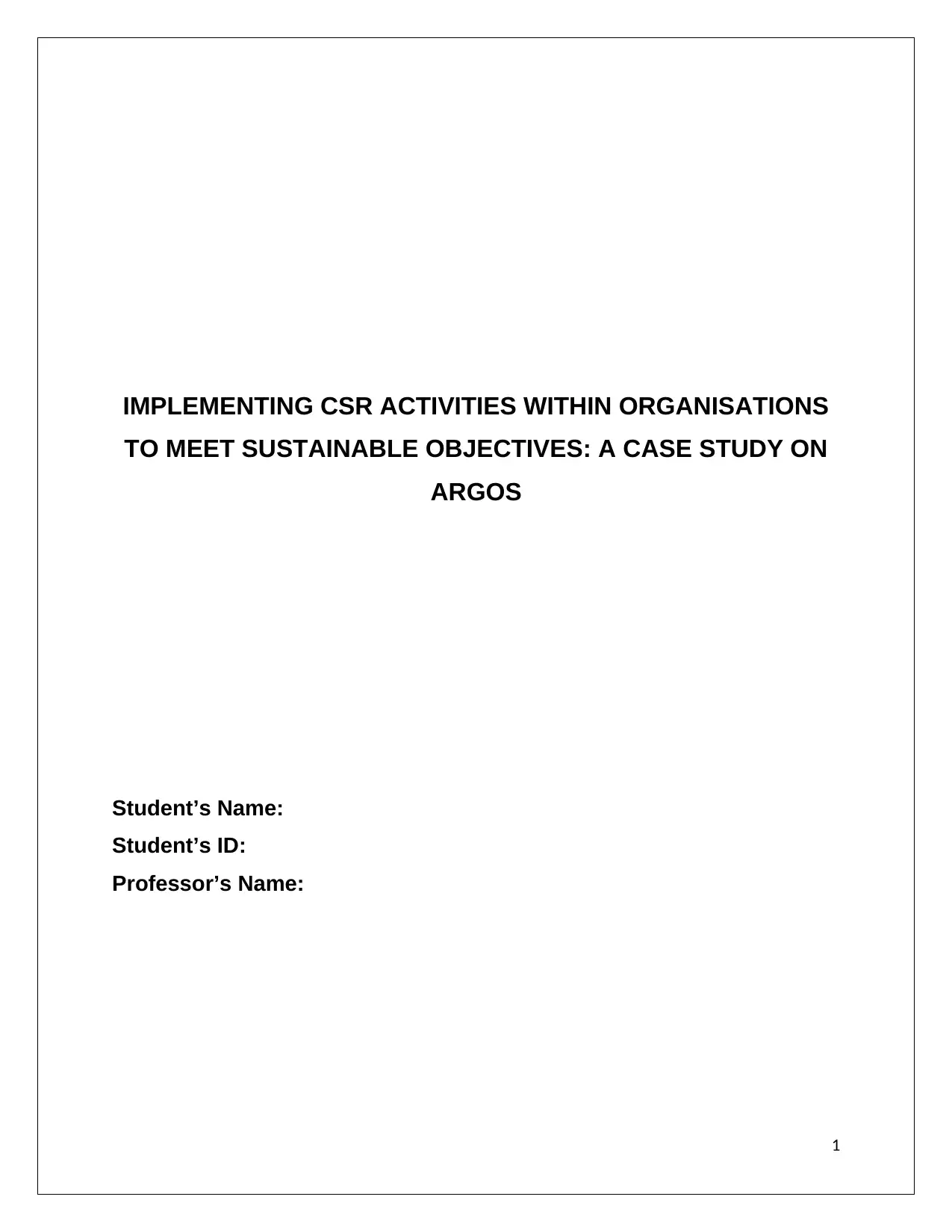
IMPLEMENTING CSR ACTIVITIES WITHIN ORGANISATIONS
TO MEET SUSTAINABLE OBJECTIVES: A CASE STUDY ON
ARGOS
Student’s Name:
Student’s ID:
Professor’s Name:
1
TO MEET SUSTAINABLE OBJECTIVES: A CASE STUDY ON
ARGOS
Student’s Name:
Student’s ID:
Professor’s Name:
1
Paraphrase This Document
Need a fresh take? Get an instant paraphrase of this document with our AI Paraphraser
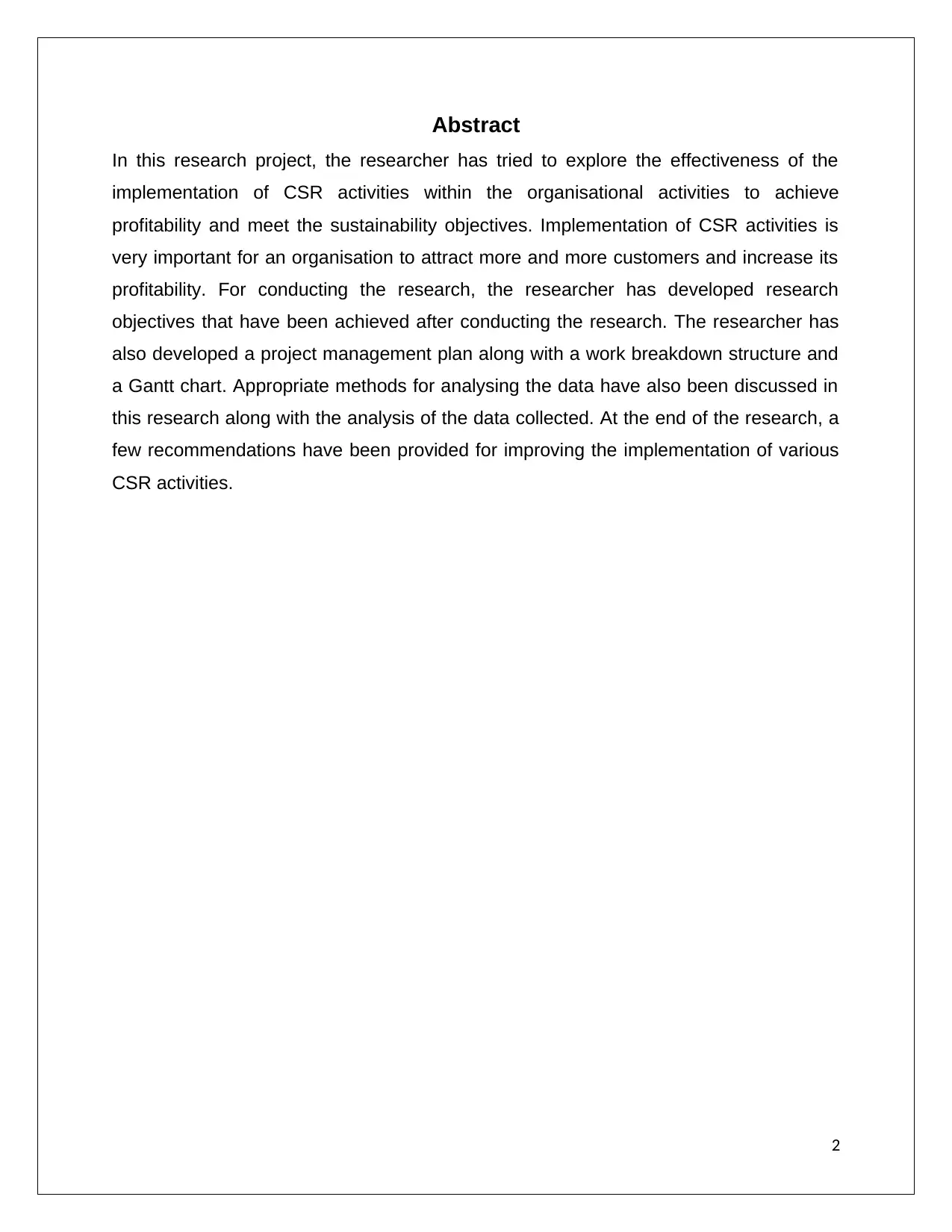
Abstract
In this research project, the researcher has tried to explore the effectiveness of the
implementation of CSR activities within the organisational activities to achieve
profitability and meet the sustainability objectives. Implementation of CSR activities is
very important for an organisation to attract more and more customers and increase its
profitability. For conducting the research, the researcher has developed research
objectives that have been achieved after conducting the research. The researcher has
also developed a project management plan along with a work breakdown structure and
a Gantt chart. Appropriate methods for analysing the data have also been discussed in
this research along with the analysis of the data collected. At the end of the research, a
few recommendations have been provided for improving the implementation of various
CSR activities.
2
In this research project, the researcher has tried to explore the effectiveness of the
implementation of CSR activities within the organisational activities to achieve
profitability and meet the sustainability objectives. Implementation of CSR activities is
very important for an organisation to attract more and more customers and increase its
profitability. For conducting the research, the researcher has developed research
objectives that have been achieved after conducting the research. The researcher has
also developed a project management plan along with a work breakdown structure and
a Gantt chart. Appropriate methods for analysing the data have also been discussed in
this research along with the analysis of the data collected. At the end of the research, a
few recommendations have been provided for improving the implementation of various
CSR activities.
2
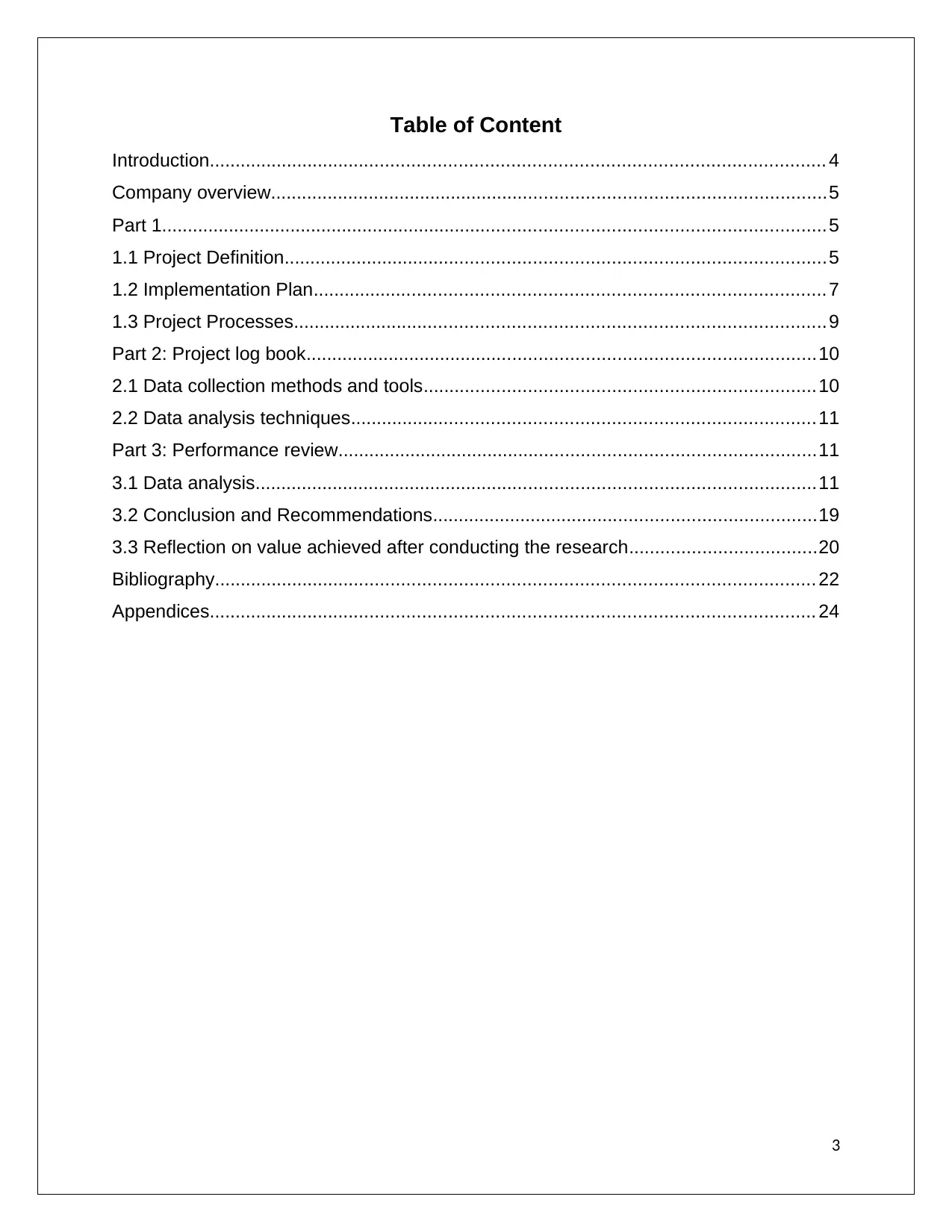
Table of Content
Introduction...................................................................................................................... 4
Company overview...........................................................................................................5
Part 1................................................................................................................................5
1.1 Project Definition........................................................................................................5
1.2 Implementation Plan.................................................................................................. 7
1.3 Project Processes......................................................................................................9
Part 2: Project log book..................................................................................................10
2.1 Data collection methods and tools...........................................................................10
2.2 Data analysis techniques.........................................................................................11
Part 3: Performance review............................................................................................11
3.1 Data analysis............................................................................................................11
3.2 Conclusion and Recommendations..........................................................................19
3.3 Reflection on value achieved after conducting the research....................................20
Bibliography................................................................................................................... 22
Appendices.................................................................................................................... 24
3
Introduction...................................................................................................................... 4
Company overview...........................................................................................................5
Part 1................................................................................................................................5
1.1 Project Definition........................................................................................................5
1.2 Implementation Plan.................................................................................................. 7
1.3 Project Processes......................................................................................................9
Part 2: Project log book..................................................................................................10
2.1 Data collection methods and tools...........................................................................10
2.2 Data analysis techniques.........................................................................................11
Part 3: Performance review............................................................................................11
3.1 Data analysis............................................................................................................11
3.2 Conclusion and Recommendations..........................................................................19
3.3 Reflection on value achieved after conducting the research....................................20
Bibliography................................................................................................................... 22
Appendices.................................................................................................................... 24
3
⊘ This is a preview!⊘
Do you want full access?
Subscribe today to unlock all pages.

Trusted by 1+ million students worldwide
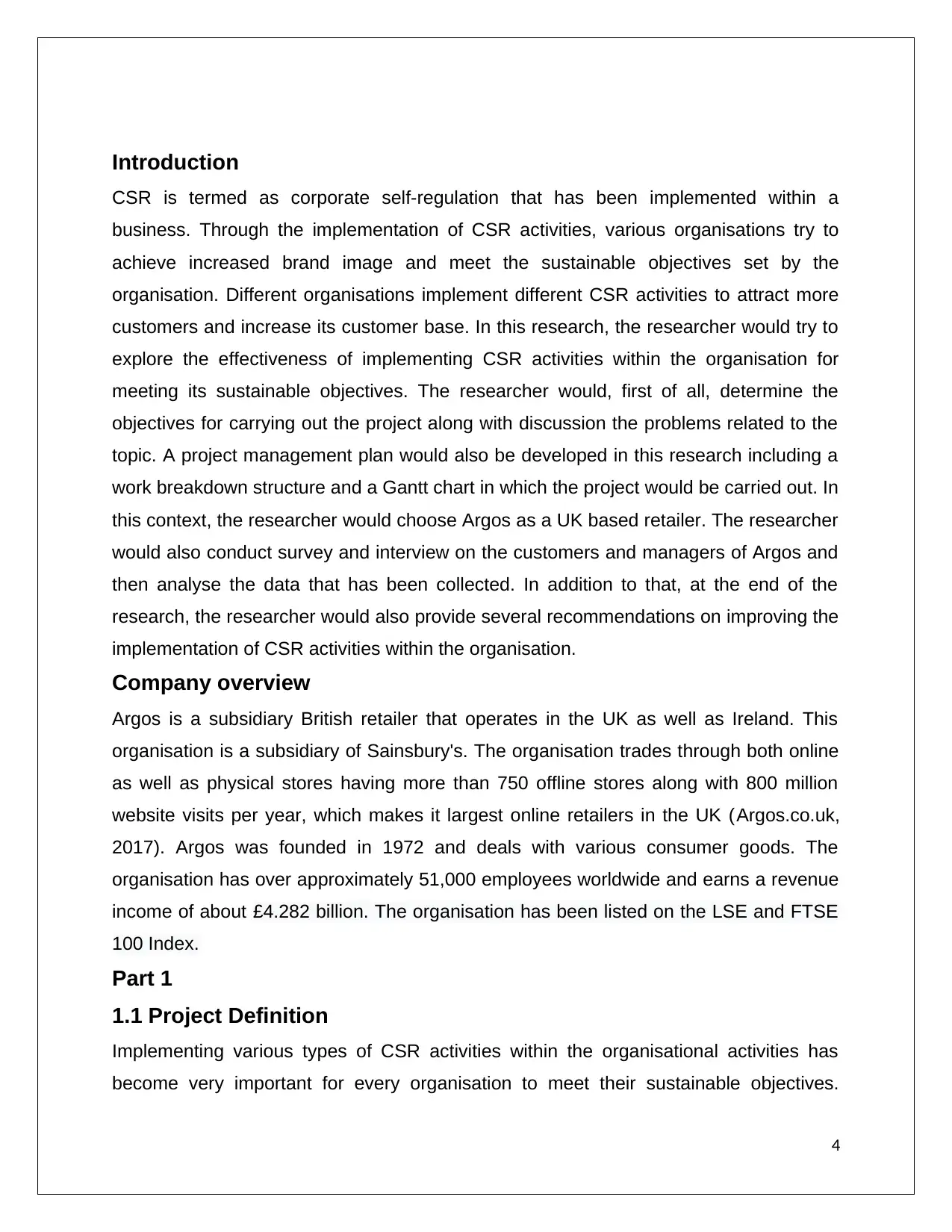
Introduction
CSR is termed as corporate self-regulation that has been implemented within a
business. Through the implementation of CSR activities, various organisations try to
achieve increased brand image and meet the sustainable objectives set by the
organisation. Different organisations implement different CSR activities to attract more
customers and increase its customer base. In this research, the researcher would try to
explore the effectiveness of implementing CSR activities within the organisation for
meeting its sustainable objectives. The researcher would, first of all, determine the
objectives for carrying out the project along with discussion the problems related to the
topic. A project management plan would also be developed in this research including a
work breakdown structure and a Gantt chart in which the project would be carried out. In
this context, the researcher would choose Argos as a UK based retailer. The researcher
would also conduct survey and interview on the customers and managers of Argos and
then analyse the data that has been collected. In addition to that, at the end of the
research, the researcher would also provide several recommendations on improving the
implementation of CSR activities within the organisation.
Company overview
Argos is a subsidiary British retailer that operates in the UK as well as Ireland. This
organisation is a subsidiary of Sainsbury's. The organisation trades through both online
as well as physical stores having more than 750 offline stores along with 800 million
website visits per year, which makes it largest online retailers in the UK (Argos.co.uk,
2017). Argos was founded in 1972 and deals with various consumer goods. The
organisation has over approximately 51,000 employees worldwide and earns a revenue
income of about £4.282 billion. The organisation has been listed on the LSE and FTSE
100 Index.
Part 1
1.1 Project Definition
Implementing various types of CSR activities within the organisational activities has
become very important for every organisation to meet their sustainable objectives.
4
CSR is termed as corporate self-regulation that has been implemented within a
business. Through the implementation of CSR activities, various organisations try to
achieve increased brand image and meet the sustainable objectives set by the
organisation. Different organisations implement different CSR activities to attract more
customers and increase its customer base. In this research, the researcher would try to
explore the effectiveness of implementing CSR activities within the organisation for
meeting its sustainable objectives. The researcher would, first of all, determine the
objectives for carrying out the project along with discussion the problems related to the
topic. A project management plan would also be developed in this research including a
work breakdown structure and a Gantt chart in which the project would be carried out. In
this context, the researcher would choose Argos as a UK based retailer. The researcher
would also conduct survey and interview on the customers and managers of Argos and
then analyse the data that has been collected. In addition to that, at the end of the
research, the researcher would also provide several recommendations on improving the
implementation of CSR activities within the organisation.
Company overview
Argos is a subsidiary British retailer that operates in the UK as well as Ireland. This
organisation is a subsidiary of Sainsbury's. The organisation trades through both online
as well as physical stores having more than 750 offline stores along with 800 million
website visits per year, which makes it largest online retailers in the UK (Argos.co.uk,
2017). Argos was founded in 1972 and deals with various consumer goods. The
organisation has over approximately 51,000 employees worldwide and earns a revenue
income of about £4.282 billion. The organisation has been listed on the LSE and FTSE
100 Index.
Part 1
1.1 Project Definition
Implementing various types of CSR activities within the organisational activities has
become very important for every organisation to meet their sustainable objectives.
4
Paraphrase This Document
Need a fresh take? Get an instant paraphrase of this document with our AI Paraphraser
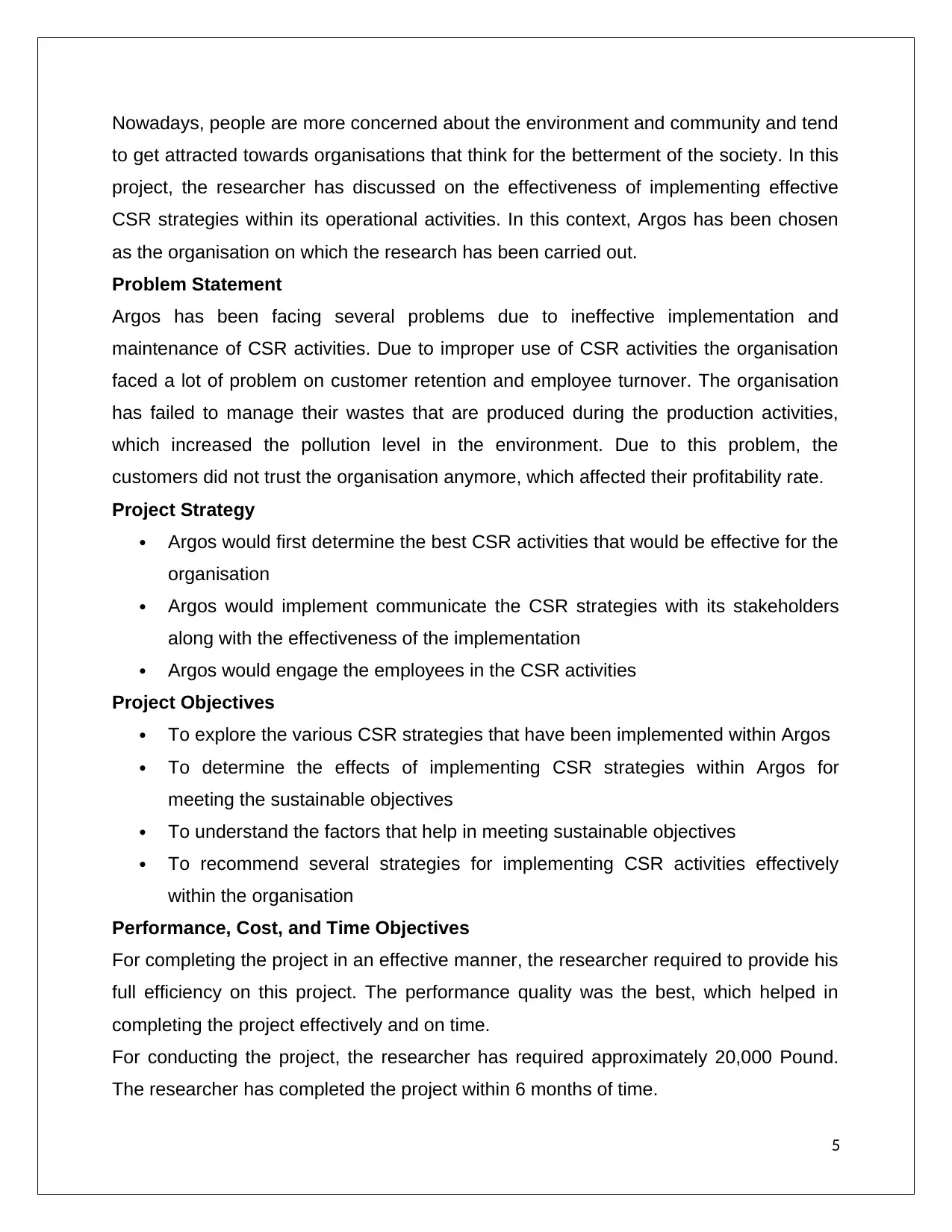
Nowadays, people are more concerned about the environment and community and tend
to get attracted towards organisations that think for the betterment of the society. In this
project, the researcher has discussed on the effectiveness of implementing effective
CSR strategies within its operational activities. In this context, Argos has been chosen
as the organisation on which the research has been carried out.
Problem Statement
Argos has been facing several problems due to ineffective implementation and
maintenance of CSR activities. Due to improper use of CSR activities the organisation
faced a lot of problem on customer retention and employee turnover. The organisation
has failed to manage their wastes that are produced during the production activities,
which increased the pollution level in the environment. Due to this problem, the
customers did not trust the organisation anymore, which affected their profitability rate.
Project Strategy
Argos would first determine the best CSR activities that would be effective for the
organisation
Argos would implement communicate the CSR strategies with its stakeholders
along with the effectiveness of the implementation
Argos would engage the employees in the CSR activities
Project Objectives
To explore the various CSR strategies that have been implemented within Argos
To determine the effects of implementing CSR strategies within Argos for
meeting the sustainable objectives
To understand the factors that help in meeting sustainable objectives
To recommend several strategies for implementing CSR activities effectively
within the organisation
Performance, Cost, and Time Objectives
For completing the project in an effective manner, the researcher required to provide his
full efficiency on this project. The performance quality was the best, which helped in
completing the project effectively and on time.
For conducting the project, the researcher has required approximately 20,000 Pound.
The researcher has completed the project within 6 months of time.
5
to get attracted towards organisations that think for the betterment of the society. In this
project, the researcher has discussed on the effectiveness of implementing effective
CSR strategies within its operational activities. In this context, Argos has been chosen
as the organisation on which the research has been carried out.
Problem Statement
Argos has been facing several problems due to ineffective implementation and
maintenance of CSR activities. Due to improper use of CSR activities the organisation
faced a lot of problem on customer retention and employee turnover. The organisation
has failed to manage their wastes that are produced during the production activities,
which increased the pollution level in the environment. Due to this problem, the
customers did not trust the organisation anymore, which affected their profitability rate.
Project Strategy
Argos would first determine the best CSR activities that would be effective for the
organisation
Argos would implement communicate the CSR strategies with its stakeholders
along with the effectiveness of the implementation
Argos would engage the employees in the CSR activities
Project Objectives
To explore the various CSR strategies that have been implemented within Argos
To determine the effects of implementing CSR strategies within Argos for
meeting the sustainable objectives
To understand the factors that help in meeting sustainable objectives
To recommend several strategies for implementing CSR activities effectively
within the organisation
Performance, Cost, and Time Objectives
For completing the project in an effective manner, the researcher required to provide his
full efficiency on this project. The performance quality was the best, which helped in
completing the project effectively and on time.
For conducting the project, the researcher has required approximately 20,000 Pound.
The researcher has completed the project within 6 months of time.
5
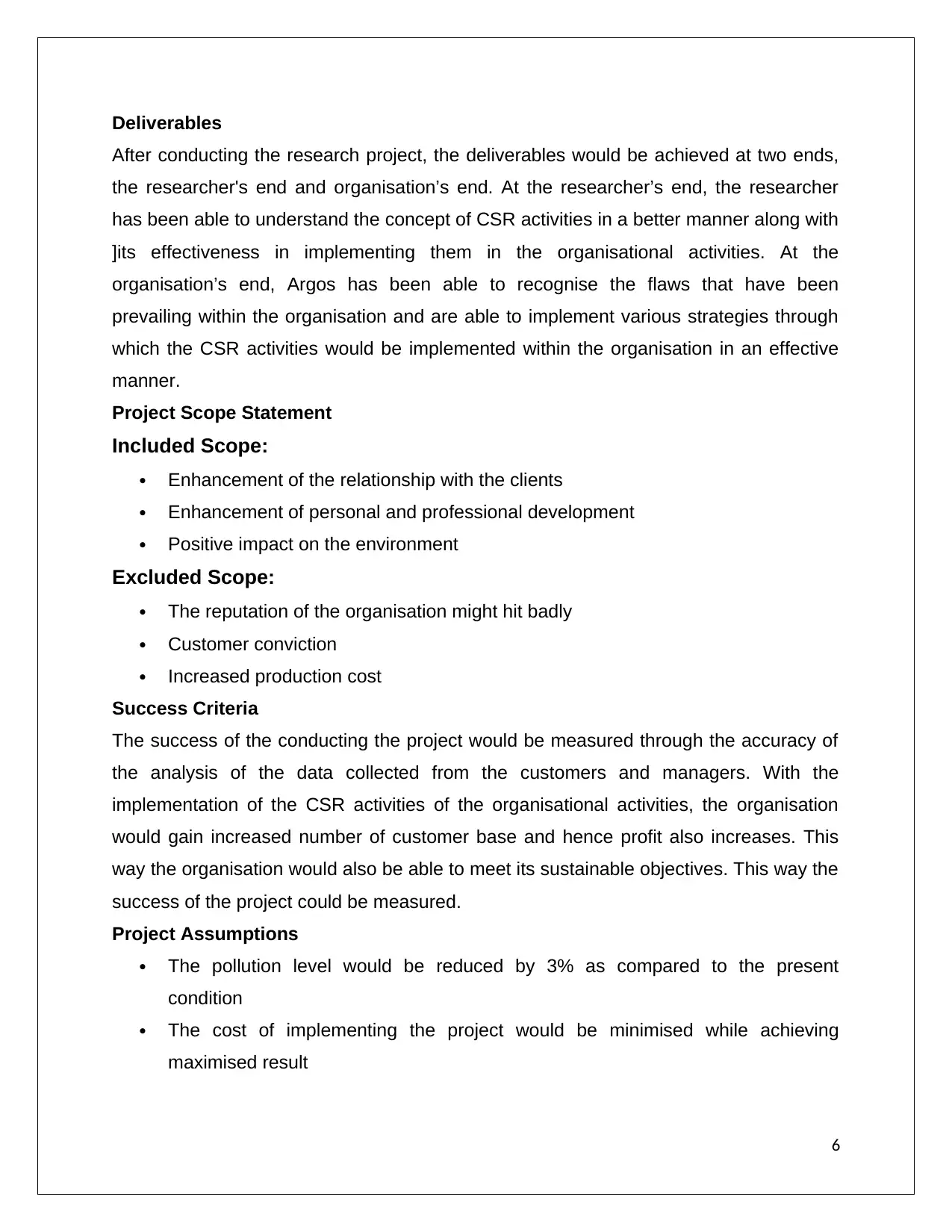
Deliverables
After conducting the research project, the deliverables would be achieved at two ends,
the researcher's end and organisation’s end. At the researcher’s end, the researcher
has been able to understand the concept of CSR activities in a better manner along with
]its effectiveness in implementing them in the organisational activities. At the
organisation’s end, Argos has been able to recognise the flaws that have been
prevailing within the organisation and are able to implement various strategies through
which the CSR activities would be implemented within the organisation in an effective
manner.
Project Scope Statement
Included Scope:
Enhancement of the relationship with the clients
Enhancement of personal and professional development
Positive impact on the environment
Excluded Scope:
The reputation of the organisation might hit badly
Customer conviction
Increased production cost
Success Criteria
The success of the conducting the project would be measured through the accuracy of
the analysis of the data collected from the customers and managers. With the
implementation of the CSR activities of the organisational activities, the organisation
would gain increased number of customer base and hence profit also increases. This
way the organisation would also be able to meet its sustainable objectives. This way the
success of the project could be measured.
Project Assumptions
The pollution level would be reduced by 3% as compared to the present
condition
The cost of implementing the project would be minimised while achieving
maximised result
6
After conducting the research project, the deliverables would be achieved at two ends,
the researcher's end and organisation’s end. At the researcher’s end, the researcher
has been able to understand the concept of CSR activities in a better manner along with
]its effectiveness in implementing them in the organisational activities. At the
organisation’s end, Argos has been able to recognise the flaws that have been
prevailing within the organisation and are able to implement various strategies through
which the CSR activities would be implemented within the organisation in an effective
manner.
Project Scope Statement
Included Scope:
Enhancement of the relationship with the clients
Enhancement of personal and professional development
Positive impact on the environment
Excluded Scope:
The reputation of the organisation might hit badly
Customer conviction
Increased production cost
Success Criteria
The success of the conducting the project would be measured through the accuracy of
the analysis of the data collected from the customers and managers. With the
implementation of the CSR activities of the organisational activities, the organisation
would gain increased number of customer base and hence profit also increases. This
way the organisation would also be able to meet its sustainable objectives. This way the
success of the project could be measured.
Project Assumptions
The pollution level would be reduced by 3% as compared to the present
condition
The cost of implementing the project would be minimised while achieving
maximised result
6
⊘ This is a preview!⊘
Do you want full access?
Subscribe today to unlock all pages.

Trusted by 1+ million students worldwide
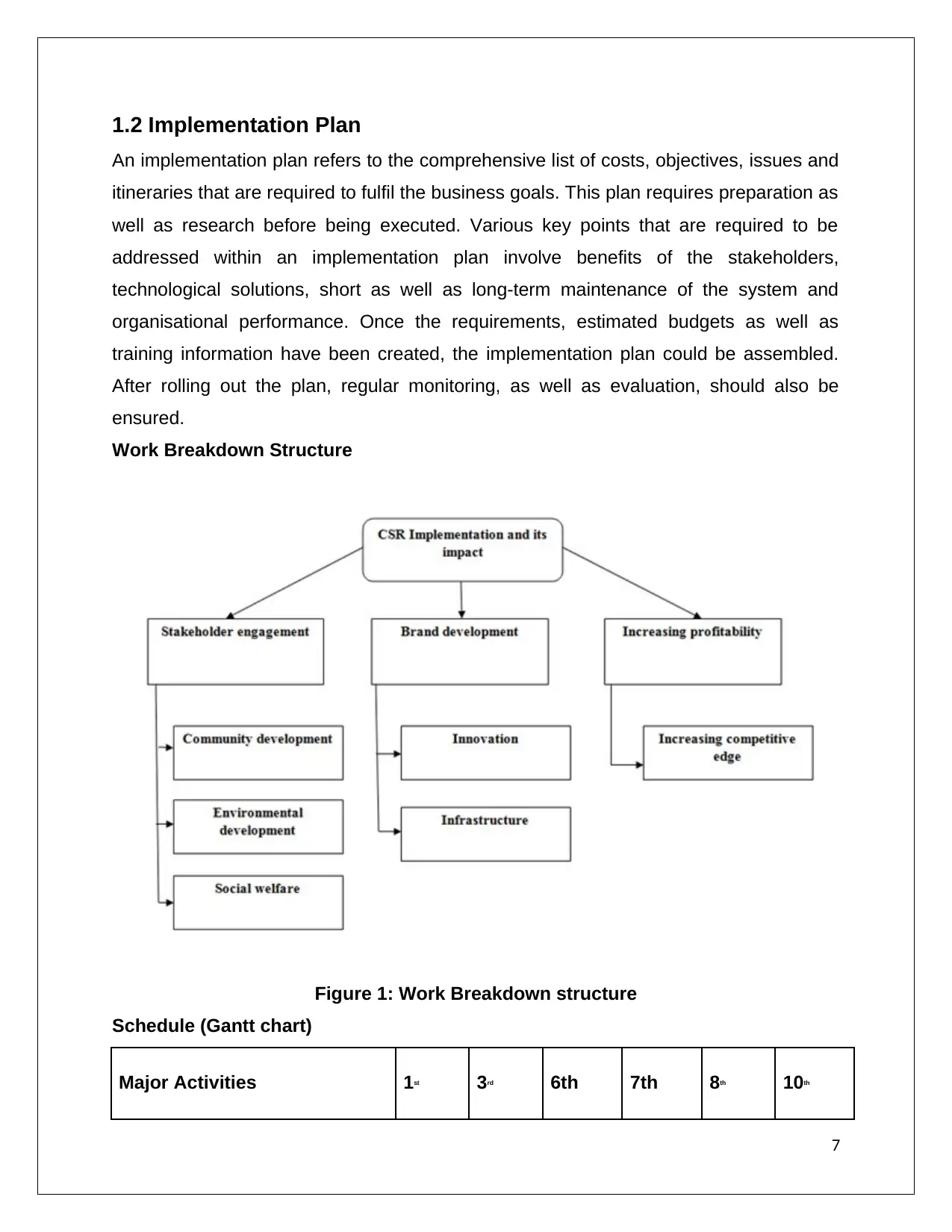
1.2 Implementation Plan
An implementation plan refers to the comprehensive list of costs, objectives, issues and
itineraries that are required to fulfil the business goals. This plan requires preparation as
well as research before being executed. Various key points that are required to be
addressed within an implementation plan involve benefits of the stakeholders,
technological solutions, short as well as long-term maintenance of the system and
organisational performance. Once the requirements, estimated budgets as well as
training information have been created, the implementation plan could be assembled.
After rolling out the plan, regular monitoring, as well as evaluation, should also be
ensured.
Work Breakdown Structure
Figure 1: Work Breakdown structure
Schedule (Gantt chart)
Major Activities 1st 3rd 6th 7th 8th 10th
7
An implementation plan refers to the comprehensive list of costs, objectives, issues and
itineraries that are required to fulfil the business goals. This plan requires preparation as
well as research before being executed. Various key points that are required to be
addressed within an implementation plan involve benefits of the stakeholders,
technological solutions, short as well as long-term maintenance of the system and
organisational performance. Once the requirements, estimated budgets as well as
training information have been created, the implementation plan could be assembled.
After rolling out the plan, regular monitoring, as well as evaluation, should also be
ensured.
Work Breakdown Structure
Figure 1: Work Breakdown structure
Schedule (Gantt chart)
Major Activities 1st 3rd 6th 7th 8th 10th
7
Paraphrase This Document
Need a fresh take? Get an instant paraphrase of this document with our AI Paraphraser
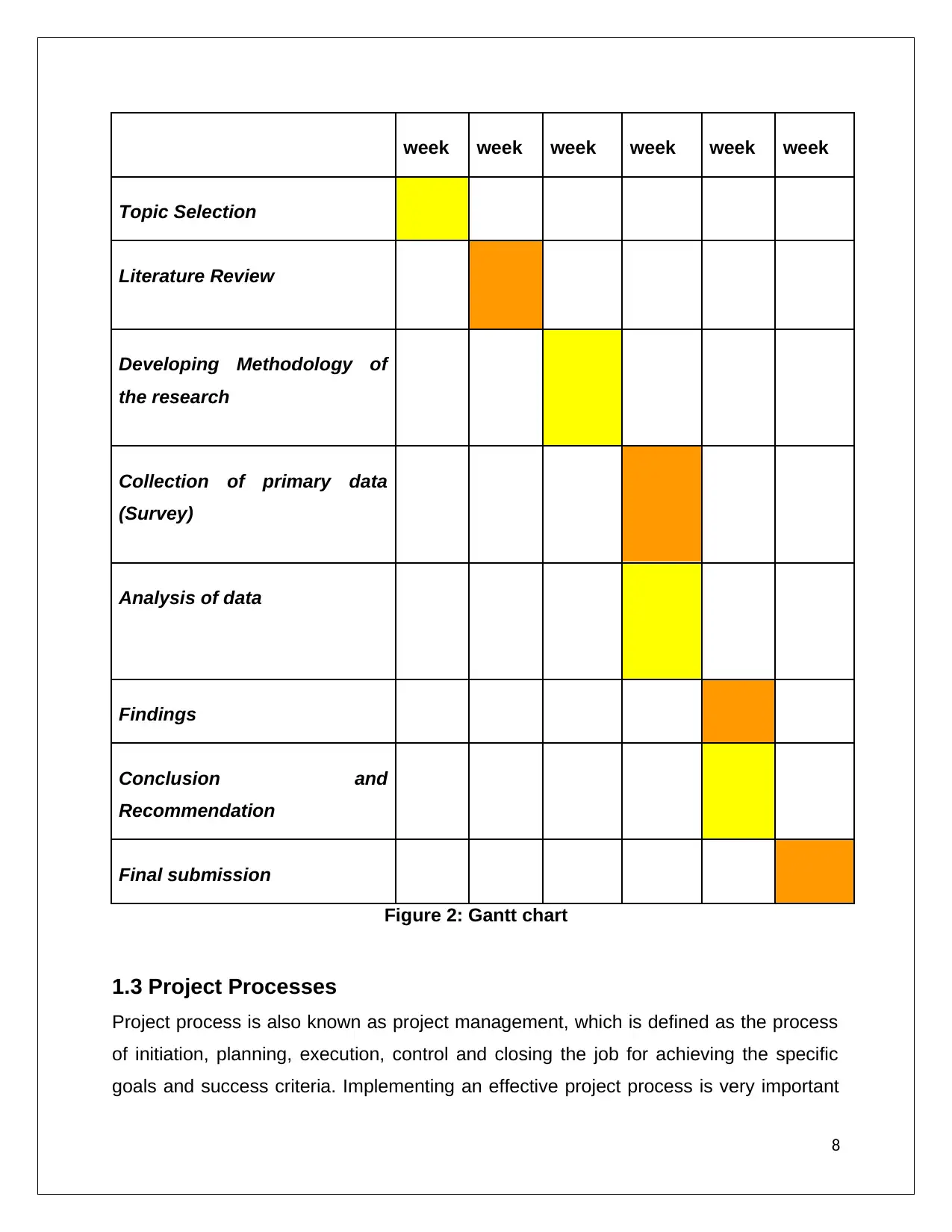
week week week week week week
Topic Selection
Literature Review
Developing Methodology of
the research
Collection of primary data
(Survey)
Analysis of data
Findings
Conclusion and
Recommendation
Final submission
Figure 2: Gantt chart
1.3 Project Processes
Project process is also known as project management, which is defined as the process
of initiation, planning, execution, control and closing the job for achieving the specific
goals and success criteria. Implementing an effective project process is very important
8
Topic Selection
Literature Review
Developing Methodology of
the research
Collection of primary data
(Survey)
Analysis of data
Findings
Conclusion and
Recommendation
Final submission
Figure 2: Gantt chart
1.3 Project Processes
Project process is also known as project management, which is defined as the process
of initiation, planning, execution, control and closing the job for achieving the specific
goals and success criteria. Implementing an effective project process is very important
8
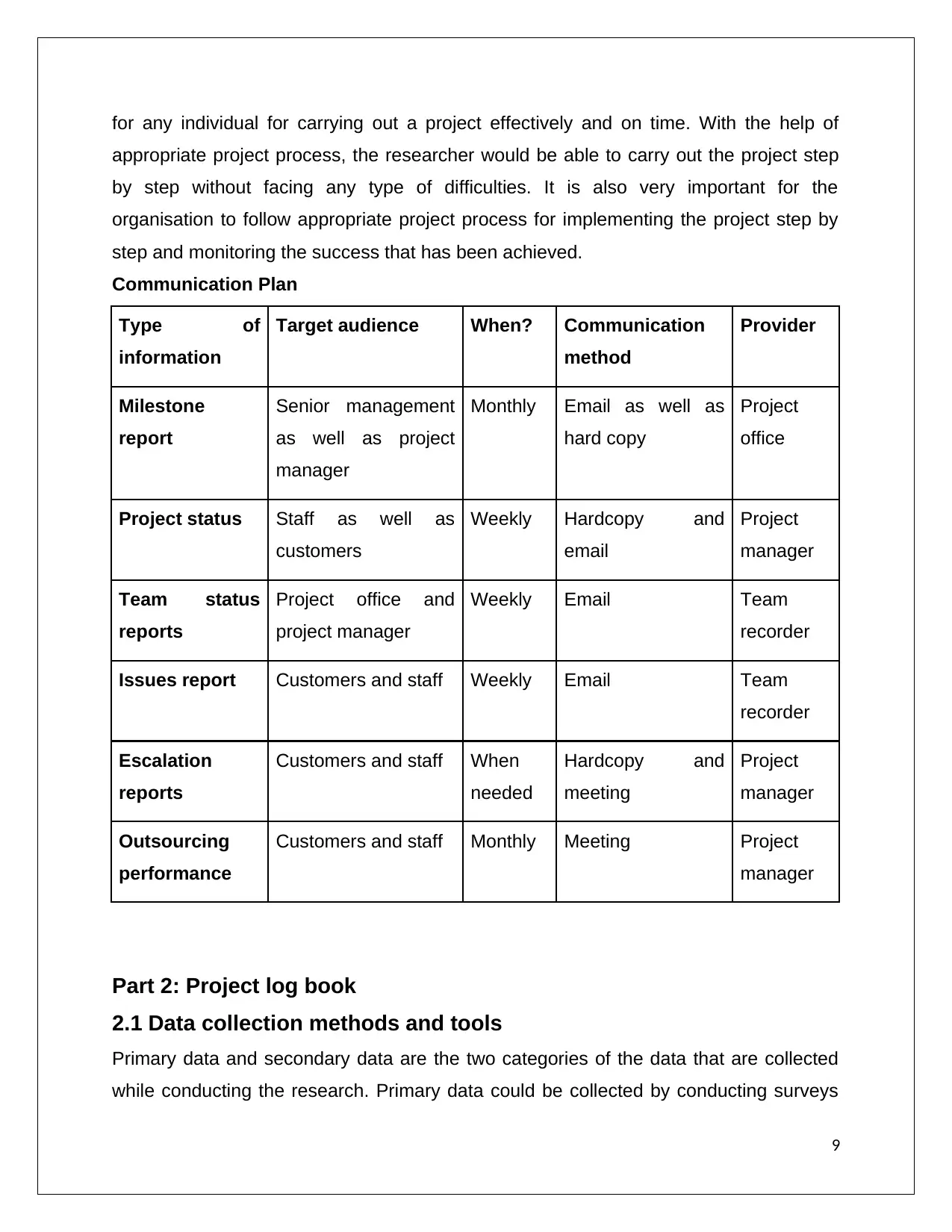
for any individual for carrying out a project effectively and on time. With the help of
appropriate project process, the researcher would be able to carry out the project step
by step without facing any type of difficulties. It is also very important for the
organisation to follow appropriate project process for implementing the project step by
step and monitoring the success that has been achieved.
Communication Plan
Type of
information
Target audience When? Communication
method
Provider
Milestone
report
Senior management
as well as project
manager
Monthly Email as well as
hard copy
Project
office
Project status Staff as well as
customers
Weekly Hardcopy and
email
Project
manager
Team status
reports
Project office and
project manager
Weekly Email Team
recorder
Issues report Customers and staff Weekly Email Team
recorder
Escalation
reports
Customers and staff When
needed
Hardcopy and
meeting
Project
manager
Outsourcing
performance
Customers and staff Monthly Meeting Project
manager
Part 2: Project log book
2.1 Data collection methods and tools
Primary data and secondary data are the two categories of the data that are collected
while conducting the research. Primary data could be collected by conducting surveys
9
appropriate project process, the researcher would be able to carry out the project step
by step without facing any type of difficulties. It is also very important for the
organisation to follow appropriate project process for implementing the project step by
step and monitoring the success that has been achieved.
Communication Plan
Type of
information
Target audience When? Communication
method
Provider
Milestone
report
Senior management
as well as project
manager
Monthly Email as well as
hard copy
Project
office
Project status Staff as well as
customers
Weekly Hardcopy and
Project
manager
Team status
reports
Project office and
project manager
Weekly Email Team
recorder
Issues report Customers and staff Weekly Email Team
recorder
Escalation
reports
Customers and staff When
needed
Hardcopy and
meeting
Project
manager
Outsourcing
performance
Customers and staff Monthly Meeting Project
manager
Part 2: Project log book
2.1 Data collection methods and tools
Primary data and secondary data are the two categories of the data that are collected
while conducting the research. Primary data could be collected by conducting surveys
9
⊘ This is a preview!⊘
Do you want full access?
Subscribe today to unlock all pages.

Trusted by 1+ million students worldwide
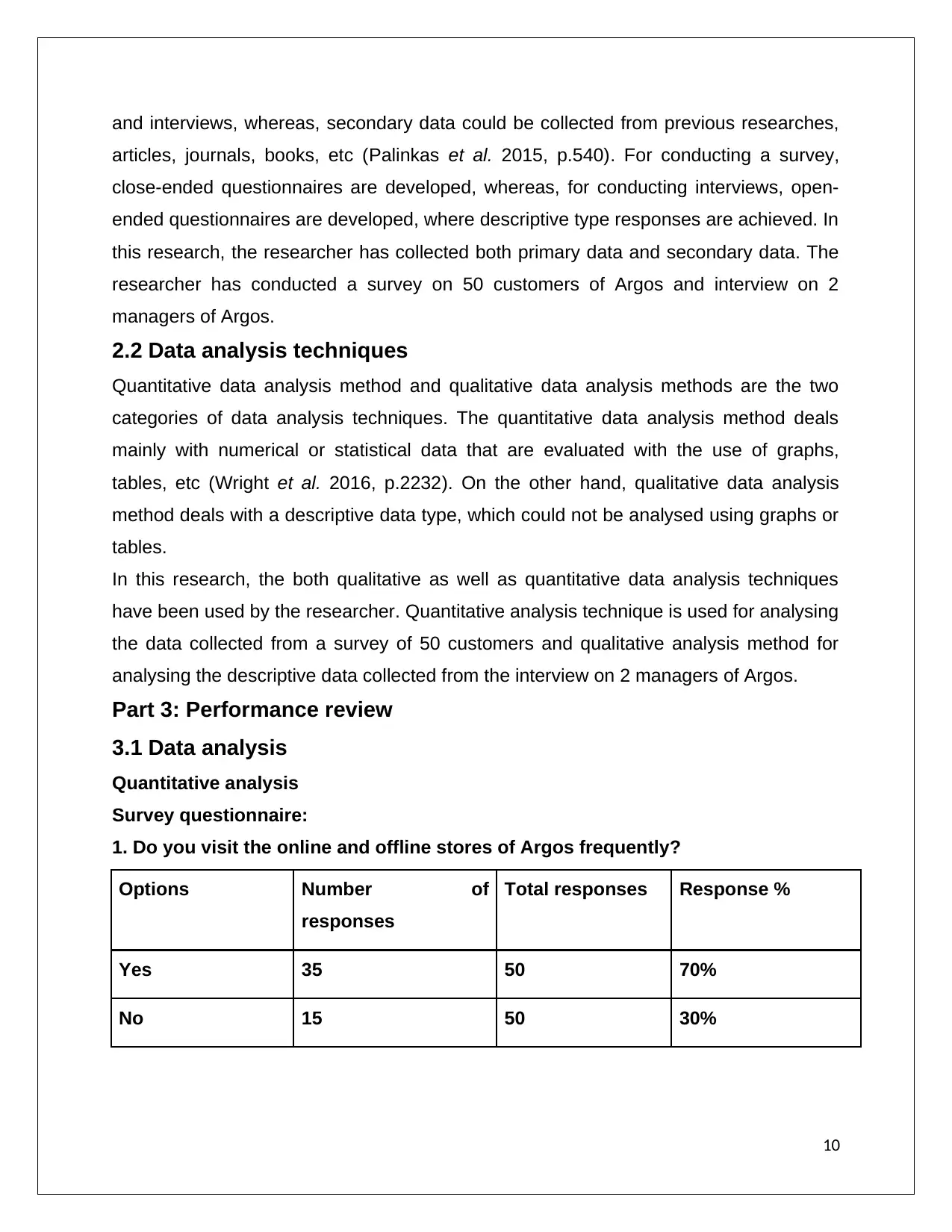
and interviews, whereas, secondary data could be collected from previous researches,
articles, journals, books, etc (Palinkas et al. 2015, p.540). For conducting a survey,
close-ended questionnaires are developed, whereas, for conducting interviews, open-
ended questionnaires are developed, where descriptive type responses are achieved. In
this research, the researcher has collected both primary data and secondary data. The
researcher has conducted a survey on 50 customers of Argos and interview on 2
managers of Argos.
2.2 Data analysis techniques
Quantitative data analysis method and qualitative data analysis methods are the two
categories of data analysis techniques. The quantitative data analysis method deals
mainly with numerical or statistical data that are evaluated with the use of graphs,
tables, etc (Wright et al. 2016, p.2232). On the other hand, qualitative data analysis
method deals with a descriptive data type, which could not be analysed using graphs or
tables.
In this research, the both qualitative as well as quantitative data analysis techniques
have been used by the researcher. Quantitative analysis technique is used for analysing
the data collected from a survey of 50 customers and qualitative analysis method for
analysing the descriptive data collected from the interview on 2 managers of Argos.
Part 3: Performance review
3.1 Data analysis
Quantitative analysis
Survey questionnaire:
1. Do you visit the online and offline stores of Argos frequently?
Options Number of
responses
Total responses Response %
Yes 35 50 70%
No 15 50 30%
10
articles, journals, books, etc (Palinkas et al. 2015, p.540). For conducting a survey,
close-ended questionnaires are developed, whereas, for conducting interviews, open-
ended questionnaires are developed, where descriptive type responses are achieved. In
this research, the researcher has collected both primary data and secondary data. The
researcher has conducted a survey on 50 customers of Argos and interview on 2
managers of Argos.
2.2 Data analysis techniques
Quantitative data analysis method and qualitative data analysis methods are the two
categories of data analysis techniques. The quantitative data analysis method deals
mainly with numerical or statistical data that are evaluated with the use of graphs,
tables, etc (Wright et al. 2016, p.2232). On the other hand, qualitative data analysis
method deals with a descriptive data type, which could not be analysed using graphs or
tables.
In this research, the both qualitative as well as quantitative data analysis techniques
have been used by the researcher. Quantitative analysis technique is used for analysing
the data collected from a survey of 50 customers and qualitative analysis method for
analysing the descriptive data collected from the interview on 2 managers of Argos.
Part 3: Performance review
3.1 Data analysis
Quantitative analysis
Survey questionnaire:
1. Do you visit the online and offline stores of Argos frequently?
Options Number of
responses
Total responses Response %
Yes 35 50 70%
No 15 50 30%
10
Paraphrase This Document
Need a fresh take? Get an instant paraphrase of this document with our AI Paraphraser
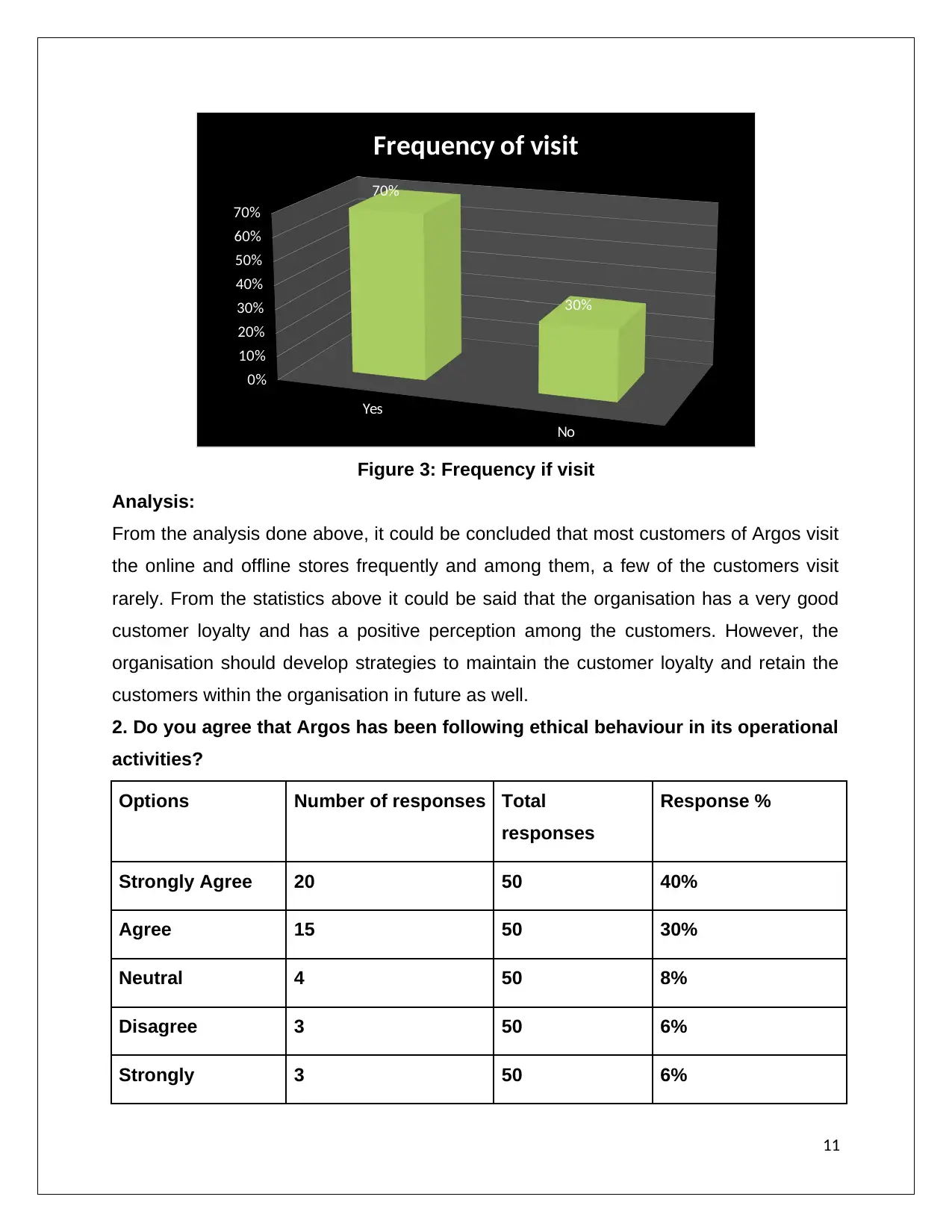
Yes
No
0%
10%
20%
30%
40%
50%
60%
70%
70%
30%
Frequency of visit
Figure 3: Frequency if visit
Analysis:
From the analysis done above, it could be concluded that most customers of Argos visit
the online and offline stores frequently and among them, a few of the customers visit
rarely. From the statistics above it could be said that the organisation has a very good
customer loyalty and has a positive perception among the customers. However, the
organisation should develop strategies to maintain the customer loyalty and retain the
customers within the organisation in future as well.
2. Do you agree that Argos has been following ethical behaviour in its operational
activities?
Options Number of responses Total
responses
Response %
Strongly Agree 20 50 40%
Agree 15 50 30%
Neutral 4 50 8%
Disagree 3 50 6%
Strongly 3 50 6%
11
No
0%
10%
20%
30%
40%
50%
60%
70%
70%
30%
Frequency of visit
Figure 3: Frequency if visit
Analysis:
From the analysis done above, it could be concluded that most customers of Argos visit
the online and offline stores frequently and among them, a few of the customers visit
rarely. From the statistics above it could be said that the organisation has a very good
customer loyalty and has a positive perception among the customers. However, the
organisation should develop strategies to maintain the customer loyalty and retain the
customers within the organisation in future as well.
2. Do you agree that Argos has been following ethical behaviour in its operational
activities?
Options Number of responses Total
responses
Response %
Strongly Agree 20 50 40%
Agree 15 50 30%
Neutral 4 50 8%
Disagree 3 50 6%
Strongly 3 50 6%
11
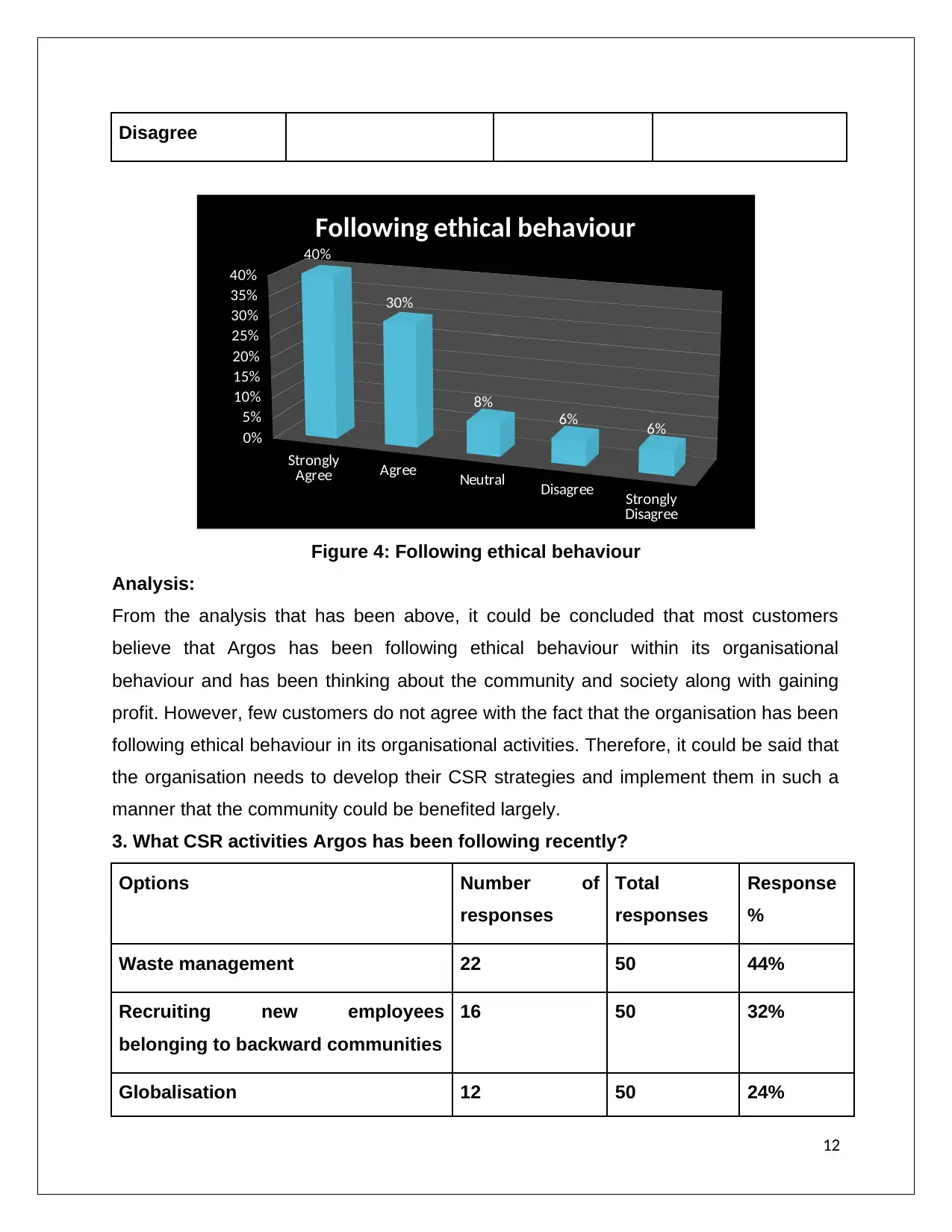
Disagree
Strongly
Agree Agree Neutral Disagree Strongly
Disagree
0%
5%
10%
15%
20%
25%
30%
35%
40%
40%
30%
8%
6% 6%
Following ethical behaviour
Figure 4: Following ethical behaviour
Analysis:
From the analysis that has been above, it could be concluded that most customers
believe that Argos has been following ethical behaviour within its organisational
behaviour and has been thinking about the community and society along with gaining
profit. However, few customers do not agree with the fact that the organisation has been
following ethical behaviour in its organisational activities. Therefore, it could be said that
the organisation needs to develop their CSR strategies and implement them in such a
manner that the community could be benefited largely.
3. What CSR activities Argos has been following recently?
Options Number of
responses
Total
responses
Response
%
Waste management 22 50 44%
Recruiting new employees
belonging to backward communities
16 50 32%
Globalisation 12 50 24%
12
Strongly
Agree Agree Neutral Disagree Strongly
Disagree
0%
5%
10%
15%
20%
25%
30%
35%
40%
40%
30%
8%
6% 6%
Following ethical behaviour
Figure 4: Following ethical behaviour
Analysis:
From the analysis that has been above, it could be concluded that most customers
believe that Argos has been following ethical behaviour within its organisational
behaviour and has been thinking about the community and society along with gaining
profit. However, few customers do not agree with the fact that the organisation has been
following ethical behaviour in its organisational activities. Therefore, it could be said that
the organisation needs to develop their CSR strategies and implement them in such a
manner that the community could be benefited largely.
3. What CSR activities Argos has been following recently?
Options Number of
responses
Total
responses
Response
%
Waste management 22 50 44%
Recruiting new employees
belonging to backward communities
16 50 32%
Globalisation 12 50 24%
12
⊘ This is a preview!⊘
Do you want full access?
Subscribe today to unlock all pages.

Trusted by 1+ million students worldwide
1 out of 23
Related Documents
Your All-in-One AI-Powered Toolkit for Academic Success.
+13062052269
info@desklib.com
Available 24*7 on WhatsApp / Email
![[object Object]](/_next/static/media/star-bottom.7253800d.svg)
Unlock your academic potential
Copyright © 2020–2025 A2Z Services. All Rights Reserved. Developed and managed by ZUCOL.





